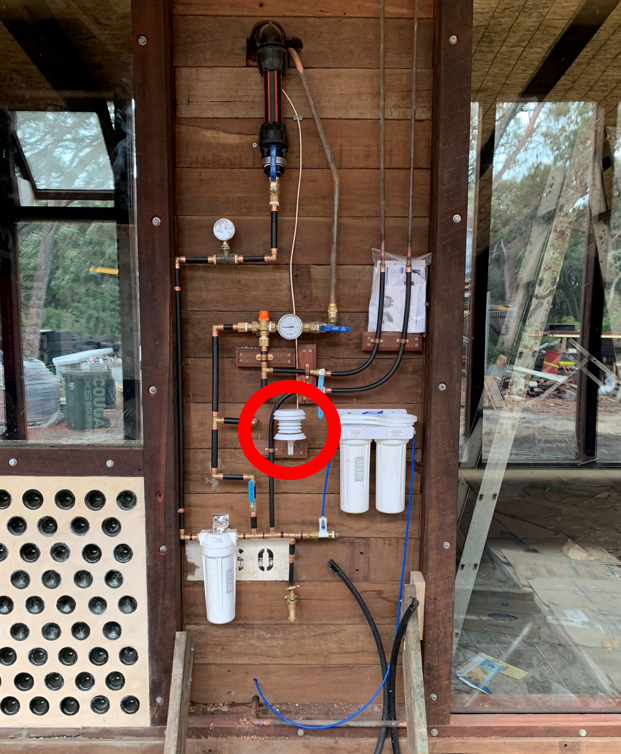Zero
Earthship Zero is loosely based on the "Encounter" Earthship designed by the inventor of Earthships, Michael Reynolds of Earthship Biotecture in the USA.
This Earthship Eco Homes design is called Zero because it has zero energy use for heating and cooling, at least that is what the first prototype has achieved in East Augusta, Western Australia.
The Earthship East Augusta project is the first iteration of this design in Australia. Also known as "Earth 1", Clive Digney is the proud owner. The indoor and outdoor temperature is recorded every half hour. Look at the graphs below which show the amazingly stable and comfortable indoor temperature.
This home stays between 20 and 24.5 degrees Celsius, without air con, without a heater - it just does it naturally.
In Australia all new homes (and extensions) must have an energy rating, a prediction of how much energy will be used, especially the energy used for heating and cooling the home. The system is called NatHERS. 7 out of 10 stars is the minimum rating and this is what all the big home builders aim for. A 10 star home (the best) is allowed to use a small amount of energy for heating and cooling, whereas this building needs none, so it has actually exceed the highest standard.
Add to this the fact that this Earthship Eco Home is built out of "waste" materials such as car tyres and salvaged jarrah timber that would have been sent to landfill; this reduces carbon emission and pollution associated with construction of the home.
This Earthship Eco Homes design is called Zero because it has zero energy use for heating and cooling, at least that is what the first prototype has achieved in East Augusta, Western Australia.
The Earthship East Augusta project is the first iteration of this design in Australia. Also known as "Earth 1", Clive Digney is the proud owner. The indoor and outdoor temperature is recorded every half hour. Look at the graphs below which show the amazingly stable and comfortable indoor temperature.
This home stays between 20 and 24.5 degrees Celsius, without air con, without a heater - it just does it naturally.
In Australia all new homes (and extensions) must have an energy rating, a prediction of how much energy will be used, especially the energy used for heating and cooling the home. The system is called NatHERS. 7 out of 10 stars is the minimum rating and this is what all the big home builders aim for. A 10 star home (the best) is allowed to use a small amount of energy for heating and cooling, whereas this building needs none, so it has actually exceed the highest standard.
Add to this the fact that this Earthship Eco Home is built out of "waste" materials such as car tyres and salvaged jarrah timber that would have been sent to landfill; this reduces carbon emission and pollution associated with construction of the home.
Renderings and floor plan below of the Zero with 2 bedrooms (as you add more bedrooms and bathrooms the building simply gets longer in the east west direction).
Section view through bathroom/laundry showing earthtube (left) and wastewater plumbing from laundry and bathroom into indoor planter and overflow out to septic tank.
Thermal Performance
It is quite rare for someone's home to be studied in such detail. Here is SCIENTIFIC DATA that demonstrates the extreme energy efficiency of this Earthship home in East Augusta, Western Australia.
The indoor and outdoor temperature is measured and recorded every 5 minutes. The temperature in the greenhouse (sunroom) is also recorded.
The graphs below show a hot summer week and a cold winter week. You can see how stable the indoor temperature is - it stays between approx 20C and 24C without the need for heating or cooling devices such as air conditioners. It simply uses an extreme form of passive solar design called... Earthship!
The indoor and outdoor temperature is measured and recorded every 5 minutes. The temperature in the greenhouse (sunroom) is also recorded.
The graphs below show a hot summer week and a cold winter week. You can see how stable the indoor temperature is - it stays between approx 20C and 24C without the need for heating or cooling devices such as air conditioners. It simply uses an extreme form of passive solar design called... Earthship!
Weather station outside Earth 1: temperature and humidity, wind speed and direction, solar radiation (how strong is the sun shining?)
Temperature and humidity sensor in the greenhouse of Earth 1












